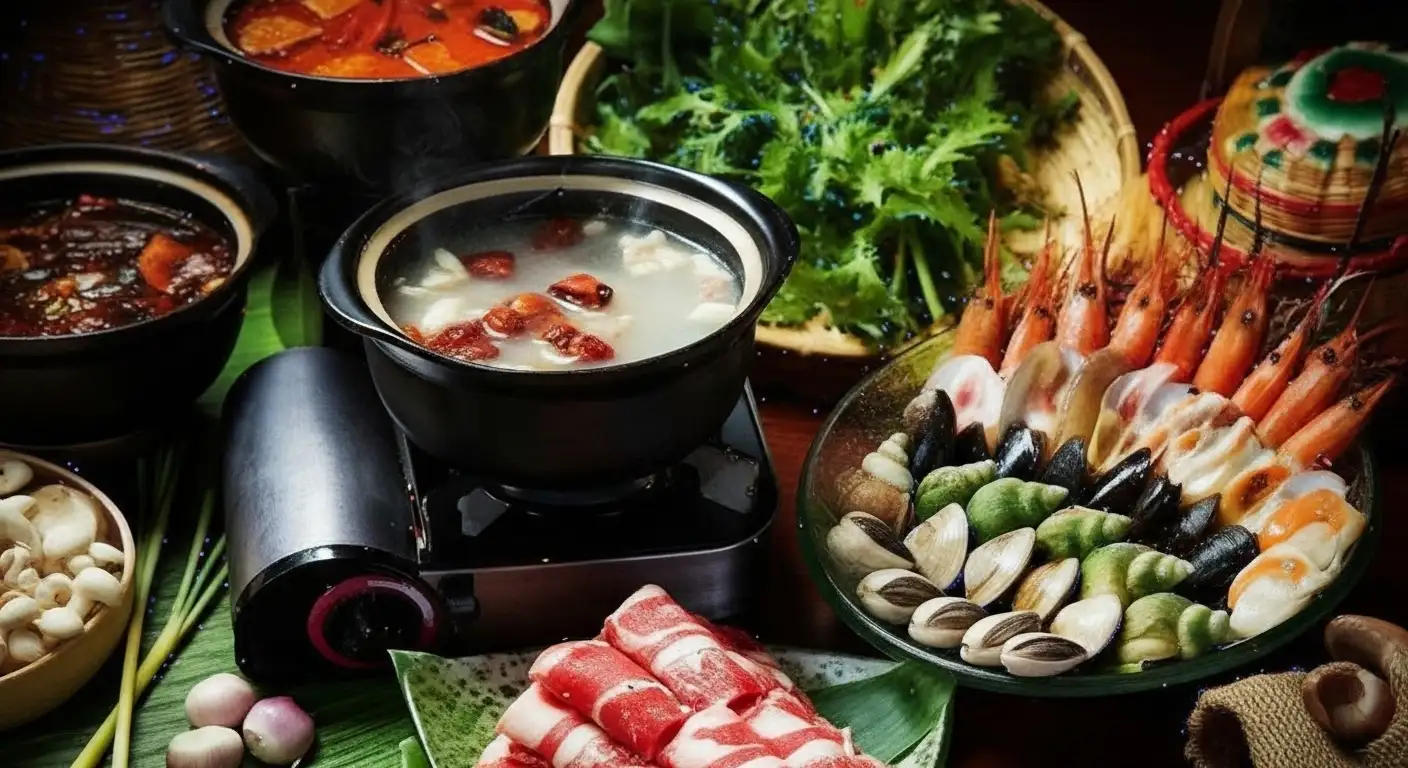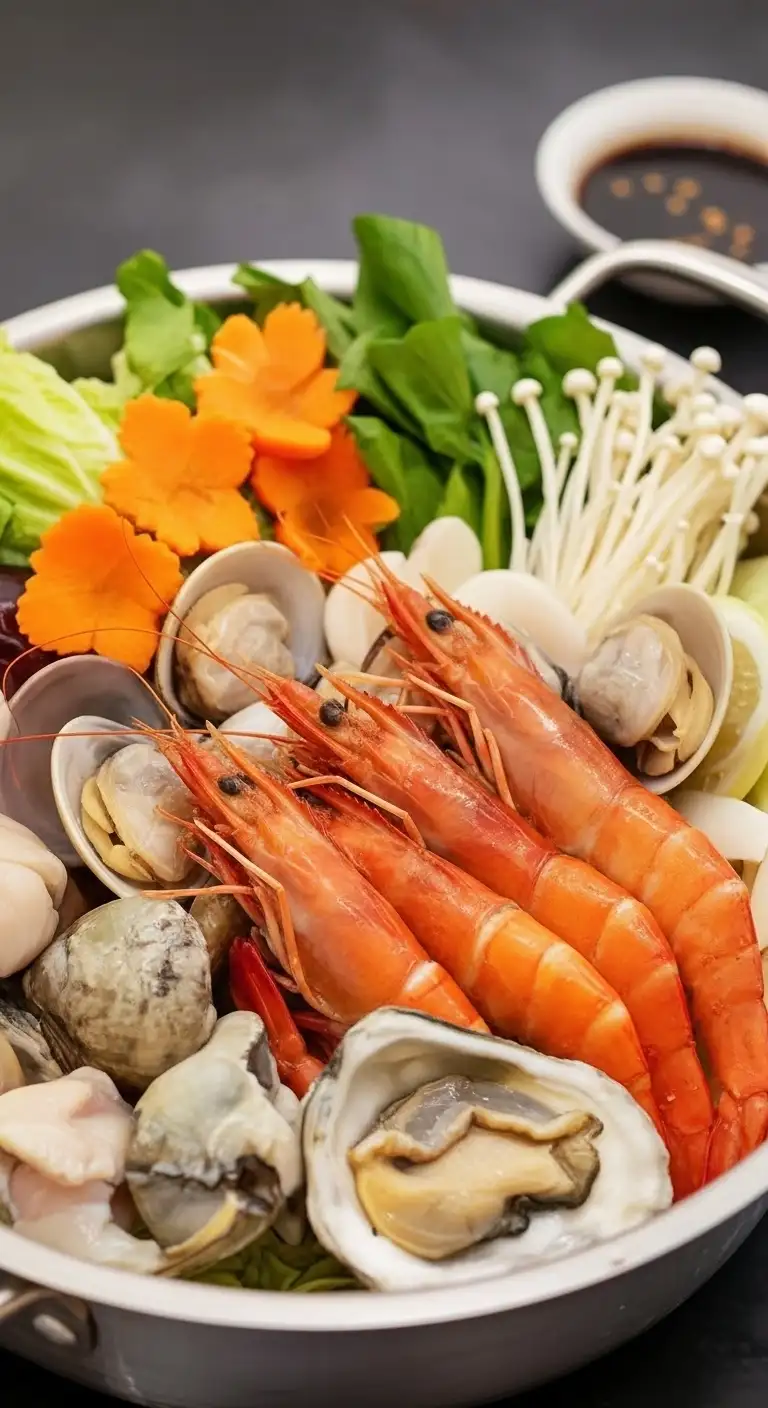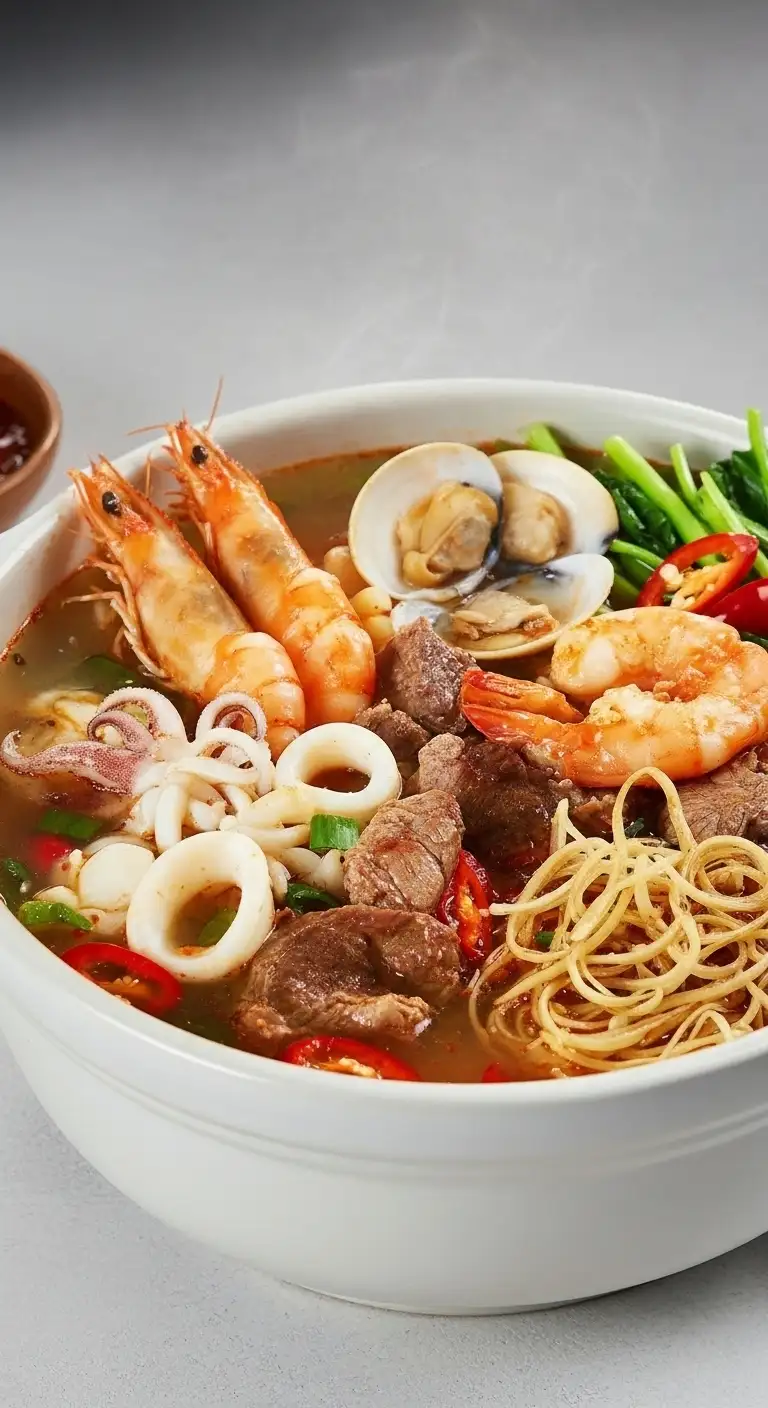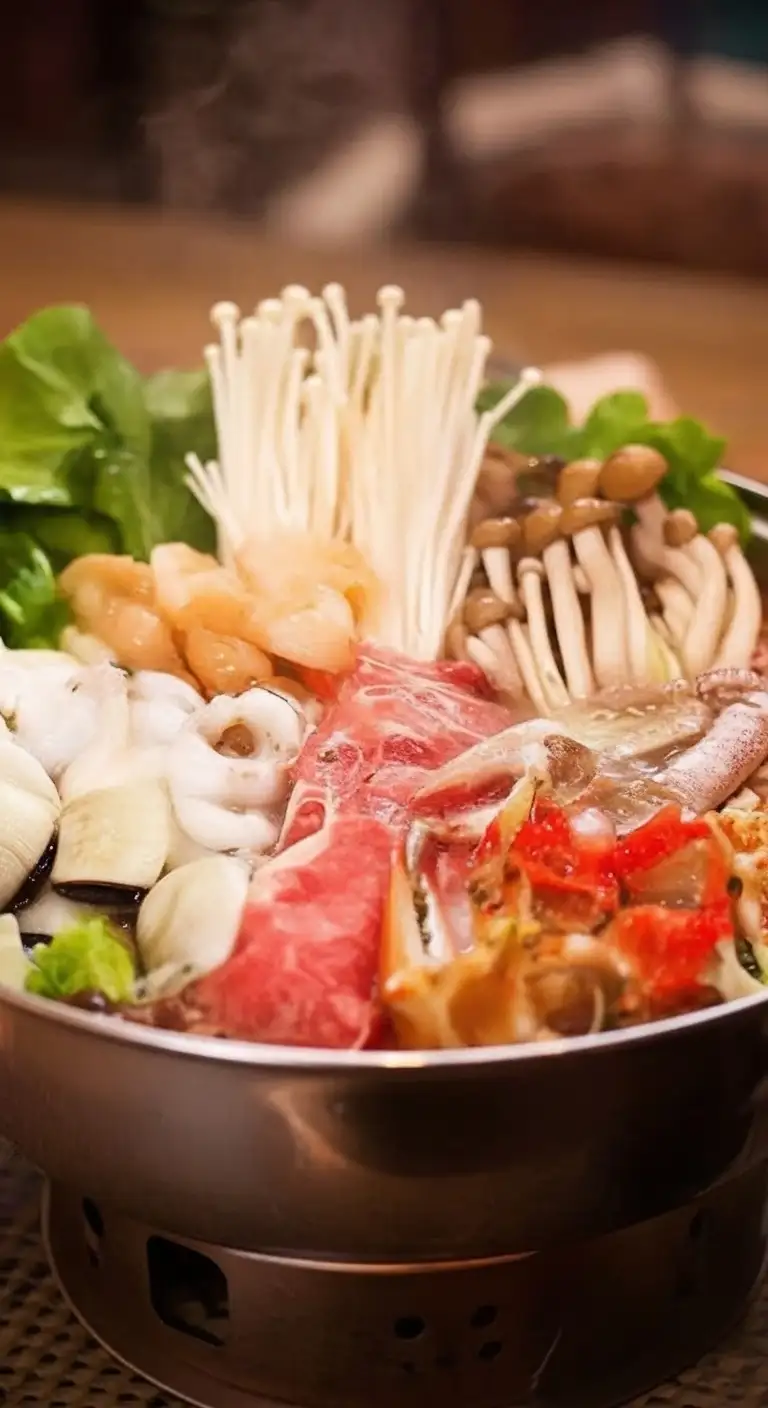Lẩu Hải Sản (pronounced Low Hiy San), or Seafood Hot Pot, is an essential dish in Vietnam’s culinary repertoire, a testament to the country’s long, resource-rich coastline. This communal meal is a celebration of fresh ocean flavors, featuring a generous assortment of shrimp, squid, fish, and clams cooked in a bright, aromatic broth right at the table.
Basic Information on Lẩu Hải Sản
What is Lẩu Hải Sản?
Lẩu Hải Sản is a versatile hot pot that centers around a bountiful platter of raw or semi-cooked seafood. The broth is designed to enhance the natural sweetness of the seafood, making it a light, refreshing, and popular choice, especially in Vietnam’s coastal and southern regions.
The Broth (Nước Lẩu):
The broth is the heart of the dish, typically a sweet and sour base (canh chua style), flavored intensely with lemongrass, galangal, kaffir lime leaves, chili, and often tomatoes and pineapple for acidity and color. The base stock is usually made from shrimp shells and fish bones to ensure an authentic marine flavor.
Key Ingredients:
Seafood: An impressive mix, commonly including shrimp, squid, fish slices (like snapper or basa), mussels, and clams.
Vegetables & Herbs: The broth is typically enhanced with water spinach (rau muống), bean sprouts, taro, bok choy, and various mushrooms.
Dipping Sauce: Cooked seafood is dipped in either a tangy salt-pepper-lime sauce (muối tiêu chanh) or a ginger fish sauce.
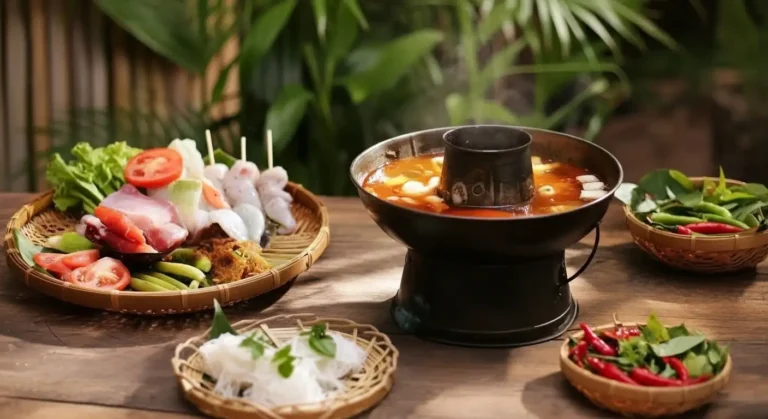
Diverse Varieties of Lẩu Hải Sản
While the term Lẩu Hải Sản can apply to any seafood-focused hot pot, specific preparations have gained fame regionally:
Lẩu Tom Yum (Lẩu Thái):
Though influenced by Thai cuisine, this is arguably the most common and globally recognized form of Vietnamese seafood hot pot. The broth is characterized by its bold, hot-and-sour flavor profile, heavily seasoned with lemongrass, galangal, and a vibrant red chili oil paste. It includes a variety of seafood and sometimes thinly sliced beef.
Lẩu Riêu Cua / Lẩu Ốc (Field Crab or Snail Hot Pot):
Primarily popular in the North, these are seafood-adjacent hot pots where the broth is based on the rich, delicate flavor of paddy field crab paste (riêu cua) or fresh snails. The resulting broth is savory, slightly tart from tomato and tamarind, and is often topped with crab roe and fish cakes.
Lẩu Thả (Phan Thiet’s “Floating” Hot Pot):
A sophisticated Central Coast specialty. While its broth is light, the presentation is unique, with raw fish, pork, eggs, and an array of herbs artfully arranged around the pot. It is eaten similarly to a hot pot, but with an emphasis on wrapping the cooked ingredients.
Lẩu Mắm (Fermented Fish Hot Pot):
A pungent Southern specialty, listed here because it uses a generous amount of river seafood (various fish, shrimp, and squid). The complex, deep umami broth is derived from fermented fish paste (mắm) and is balanced with sugar and coconut water.
How to Eat Lẩu Hải Sản
The communal nature of Lẩu Hải Sản is part of its charm. Here is the typical flow of the meal:
Prepare the Base: The simmering pot of pre-seasoned broth is placed on a tabletop burner. Initial ingredients like pineapple chunks and tomatoes are already simmering to build a deep flavor.
Cook the Proteins: Diners use chopsticks or small strainer scoops to add their desired seafood to the pot. Shellfish like clams or shrimp cook quickly (2-3 minutes) and should be pulled out immediately to avoid overcooking.
Dip and Enjoy: Once cooked, the seafood is placed in a personal bowl, where it is often dipped into a customized sauce. The tangy, simple salt, pepper, and lime dip is essential for highlighting the fresh, sweet flavor of the seafood.
Finish with Noodles: As the meal progresses and the broth becomes enriched by the seafood essence and vegetables, it is served into individual bowls over rice vermicelli noodles (bún) or instant noodles for a satisfying finale.
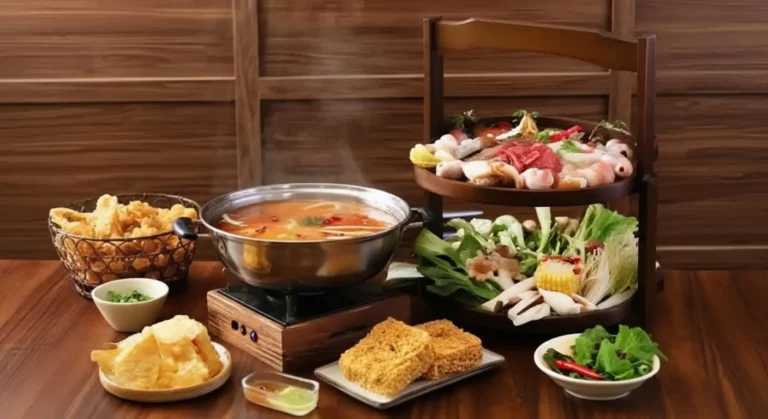
Regional Differences in Lẩu Hải Sản
Vietnam’s distinct geographical regions influence the flavors and ingredients of its hot pots, with coastal proximity playing a major role in Lẩu Hải Sản:
| Region | Flavor Tendency & Seafood Focus | Signature Seafood Lẩu Styles | Key Ingredients / Broth Note |
|---|---|---|---|
| North (Hanoi, Hai Phong) | Savory, Balanced, and Rich. Seafood hot pots often feature river or freshwater ingredients alongside marine options. | Lẩu Riêu Cua (Field Crab) or Lẩu Ốc (Snail Hot Pot). | The broth tends to be more savory and less sweet or spicy than the Southern versions, focusing on umami from crab paste, bone broth, and a gentle tartness from tomatoes/tamarind. |
| Central (Huế, Đà Nẵng) | Spicy, Aromatic, and Robust. Coastal proximity ensures fresh marine life, often paired with bold spices. | Sour and Spicy Seafood Hot Pot (often influenced by Tom Yum flavors) and Lẩu Thả. | Broth features a prominent spiciness from chili and richness from lemongrass and mắm ruốc (fermented shrimp paste). The emphasis is on fresh, clean-tasting coastal fish and shellfish. |
| South (Saigon, Mekong Delta) | Sweet, Tangy, and Abundant. Influenced by the tropical climate, the cuisine uses more sugar and tropical fruit for balance. | Lẩu Thái (Tom Yum style) and Lẩu Mắm (Fermented Fish). | The broth is often sweeter than in other regions, with a pronounced sourness from tamarind and tang from pineapple. Coconut milk or water is sometimes used to enrich the flavor, perfectly complementing the vast array of available fish and shrimp. |
